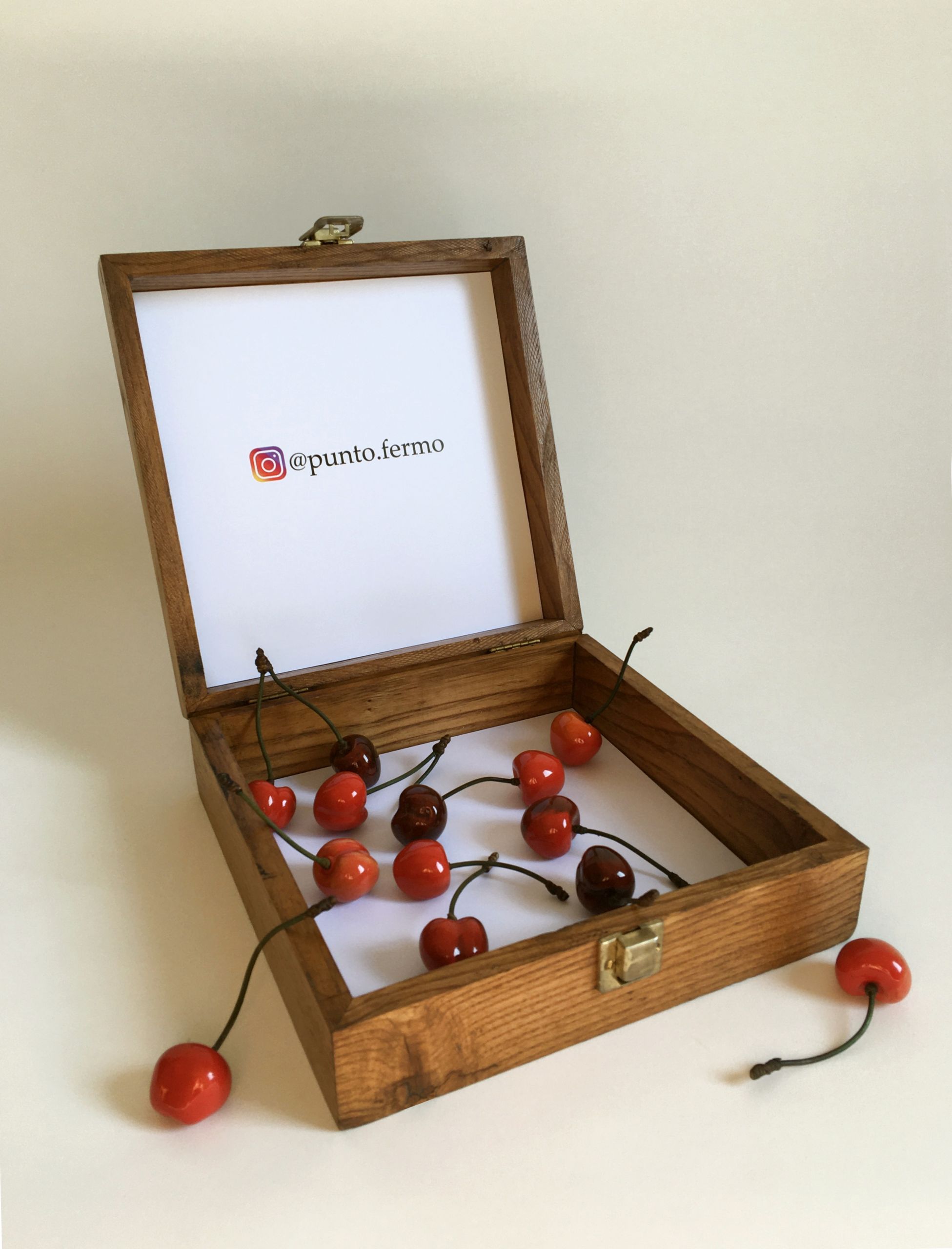Francesco Carone
Puntofermo, 2020
Enamelled pottery, brass + Instagram page (@punto.fermo)
Courtesy of the artist
Francesco Carone’s work always comes about from observing reality, whether it be tangible and natural, or fleeting and immaterial.
Puntofermo is a collection of cherries. However, they are not cherries as such, but life-sized enamelled pottery sculptures. Carone not only changes their matter but also their function: they are not for eating but for dotting the space where an exhibition is taking place. Their purpose is to be placed in different displays to show how these red dots are able to shorten or extend the distances between the works, reveal hidden similarities and outline new compositional lines.
The artist photographs each of the small sculptures as they are placed in the various exhibitions. These shots (the first of which shows them in a wooden box) are loaded on an Instagram page that he has created specially to document their path from place to place, giving a new slant on the relationship between perception, natural space and work which is characteristic of Staccioli’s sculptures.
“A few years ago, in the days coming up to the opening of a solo show, I made ten or so enamelled pottery cherries with stalks made of patinated brass. I didn’t have any specific purpose for making them but once the exhibition was set up, before the opening, I tried to arrange them among the works. There was no conceptual logic, I just followed a will that responded to my feelings of personal harmony. That handful of little red dots placed alongside or behind or above the works, or by themselves in the middle of the gallery, created a completely different overall vision; as if I’d added punctuation in a text thrown down in a stream of consciousness or inner monologue.
Then I removed them, only to put them back in a different order, having fun discovering ever changing balances, tensions and hierarchies. Then I did it again, like in a sort of self-analysis. It was getting late and so I decided to leave the ten pottery cherries in one of the most convincing positions. It was only after photographing the set that I realized I’d have to make some more little moves: however, this time it wasn’t the cherries but, paradoxically, the works themselves.
A few years on, I’ve decided to make a new set of cherries for the Toscanaincontemporanea 2020 competition-winning project. I’m going to secretly place these pieces of pottery in the exhibitions of friends and colleagues that I’ll go to visit soon in galleries, exhibition venues or permanent museum exhibitions, in the hope that I can reveal new, as yet hidden potentials. I’m going to leave them there whatever might happen to them… if they’re removed, swept away, rolled under a cupboard in the dust, stolen or kept or who knows, even left as part of the set-up forever. Before I go, I’ll document where I put them and publish the shots on an Instagram page (@punto.fermo) created for the occasion. I’m only going to do it in situations that I think deserve or need it, and above all, I’ll keep doing it until I’ve finished the cherries.” (Francesco Carone)
Francesco Carone was born in 1975 in Siena, where he lives and works.
His works are housed in some of the most prestigious Italian and foreign collections, such as the Farnesina Ministry of Foreign Affairs in Rome.
He combines traditional practice with more complex projects where the concepts of work, collection and exhibition converge in various forms. Among these, “Tempo Zulu”, a project which for years has called upon Italian and international artists and cultural workers to leave a permanent contribution engraved in the surface of the streets in the historical centre of Siena and “TITOLO l’edito inedito”, itinerant work/exhibition/library.
From 2012 to 2015 he was among the organizers of Made in Finlandia (www.madeinfilandia.org).
Together with Eugenia Vanni, he devised and founded the Museo d’Inverno (www.museodinverno.com), a space with seasonal programmes which invites artists to present a selection of other people’s works from their collections.
He has been hosted at the SpazioA gallery in Pistoia since 2006 (www.spazioa.it).
in dialogue with Mauro Staccioli, Galleria Toninelli, 1972
Photo by E. Cattaneo




